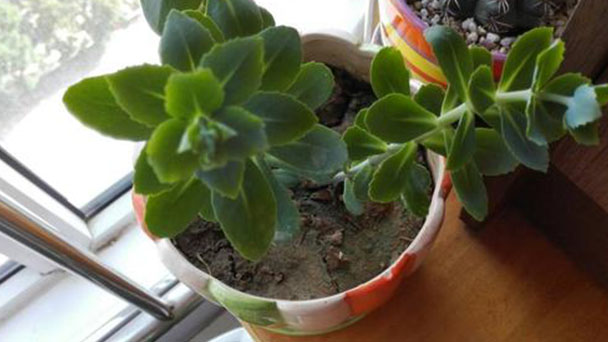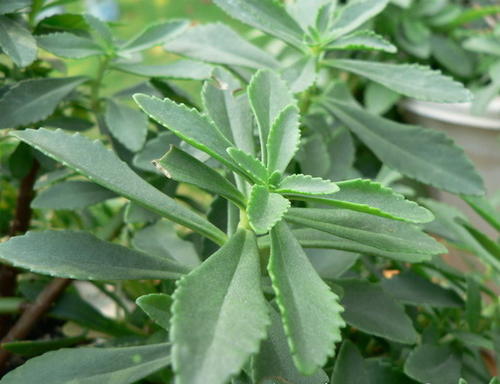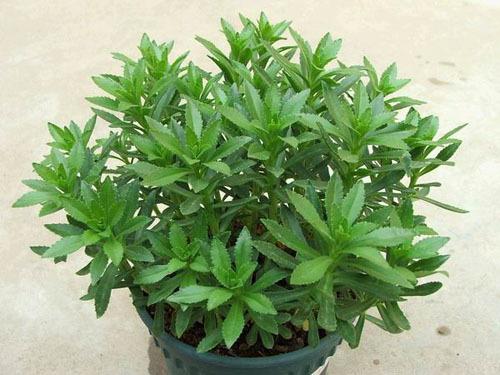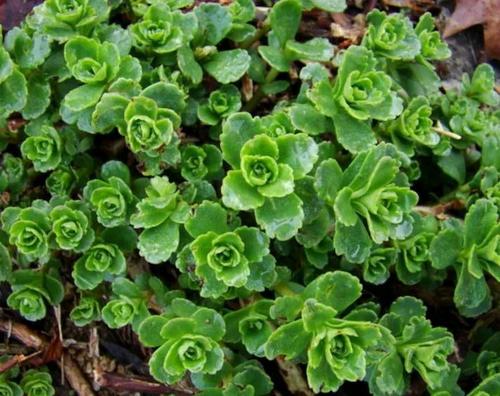Phedimus Aizoon (Aizoon Stonecrop) Profile
Written by admin
Dec 07 2021

Phedimus aizoon, also called Aizoon stonecrop, is a perennial herb of the genus Sedum in the Chrysanthemum family, with a height of 30 ~ 80cm. Phedimus aizoon stem is erect, unbranched, solitary or several stems fascicular. Leaves are simple alternate, thick, oblanceolate, 5 -- 8cm long and 1 -- 2cm wide, apex acuminate, base cuneate, margin serrate, almost sessile. Inflorescence cymes are corymbiform, terminal; Phedimus aizoon has 5 sepals, green, linear-lanceolate, unequal, 3 -- 5mm long, apex obtuse; Phedimus aizoon has 5 petals, yellow, elliptic-lanceolate, 6 -- 10mm long;Stamens 10, shorter than petals; Phedimus aizoon has 5 carpels, oval moment round, base connate, ventral with cystic protuberance. Phedimus aizoon has 5 follicles, spreading outward at maturity in a starlike arrangement.
Phedimus Aizoon Picture

Characteristics of Phedimus Aizoon
Phedimus Aizoon Rhizome
Phedimus aizoon is a perennial herb. Rhizome is short, stout 20-50 cm tall, with 1-3 stems, erect, glabrous, unbranched.
Phedimus Aizoon Leaf
Leaves of Phedimus aizoon are alternate, narrowly lanceolate, elliptic-lanceolate to ovate-oblanceolate, 3.5 -- 8 cm long and 1.2 -- 2 cm wide, apically acuminate, basally cuneate, margin irregularly serrate; Leaves are firm, subleathery.
Phedimus Aizoon Flowers
Cymes of Phedimus aizoon are multi flowered, horizontally branched, spreading, supported by bracts. phedimus aizoon has 5 sepals, linear, fleshy, unequal, 3-5 mm long, apex obtuse; Phedimus aizoon has 5 petals, yellow, oblong to elliptic-lanceolate, 6 -- 10 mm long, mucronate; Phedimus aizoon has 10 stamens, shorter than petals; Phedimus aizoon has 5 scales, subsquare, 0.3 mm long, carpel 5, ovate-oblong, basally connate, ventral convex, style long subulate.
Phedimus Aizoon Fruit
Follicles of Phedimus Aizoon in a starlike arrangement, 7 mm long; Seeds are elliptic, ca. 1 mm long.
Ecological Habits of Phedimus Aizoon
Phedimus Aizoon is born on the rocks and grass on the hillsides. It mainly produces in the north of China and the provinces of the Yangtze River basin.
Phedimus Aizoon Propagation
Phedimus aizoon can be propagated from cuttings or seeding.
How to Care for Phedimus Aizoon
Phedimus Aizoon Temperature Care
Suitable for Phedimus Aizoon growth temperature between the humidity to 30 degrees, below 5 degrees of temperature will stop growing, so in winter winter to do a good job of anti-freezing measures, especially in the north of the cultivation of plants, it is best to enter the room, and then placed in the sunny area for the winter, which can greatly improve the overwintering rate.
Phedimus Aizoon Watering
Watering time is not fixed, mainly according to the condition of the soil to decide whether to water, only when the soil is completely dry, you need to water the soil completely, but the soil can not have water, the root is not resistant to waterlogging, if there is water in the soil, it is easy to cause root rot.
Phedimus Aizoon Fertilizer
Aizoon Stonecrop should be less fertilizer, that is to say, each kind of fertilizer should not be too much, less fertilizer points, fertilization frequency is high. Organic fertilizers for flowers can be used or self-made degumming fertilizers can be produced by burying decaying Phedimus aizoon, leaves, fruits, vegetables and animal offal in the soil and fermenting them into threshing fertilizers for use in plants. The frequency of fertilization is twice a month.
Phedimus Aizoon Lighting Requirements
Phedimus Aizoon is not resistant to strong light, shading is needed when lighting, autumn and winter light intensity is weakened, the sunshine time can be appropriately extended, the sunshine time of a day generally can not be less than six hours.
Phedimus Aizoon Pests & Diseases
1. Pests: Aphids are the number one pest of Phedimus aizoon. Once found, the infected branches need to be removed and destroyed as soon as possible and then sprayed with carbendazim to increase the resistance of the pest.
2. Disease: If the branches and leaves of Phedimus Aizoon turn yellow, it may be caused by too much light, so move to a cool place, slow the seedlings for a few days, and then store the Phedimus Aizoons in a semi-negative environment..

Taxonomy of Phedimus Aizoon
Narrow leaf Phedimus aizoon (variant)
Sedum Aizoon L. F. Angustifolium Franch (Varieties) (Northeast Plant Retrieval). Leaves narrowly oblong-cuneate or almost linear, less than 5 mm wide. Gansu, Shaanxi, Shandong, Hebei, Inner Mongolia, Jilin, Heilongjiang. Born at an altitude of 1350 meters or so on the hillside shady. So did the Soviet Union.The type specimens were collected from near Beijing.
Wide-leaf Phedimus Aizoon (Variant)
Sedum Aizoon L. var. Latifolium Maxim.Leaves broadly obovate, elliptic, ovate, sometimes slightly rounded. Apex obtuse, base cuneate, 2 -- 7 cm long, up to 3 cm wide. Shandong, Hebei, Liaoning, Jilin and Heilongjiang.So did North Korea and the Soviet Union. The type specimens were collected from Northeast China.
Milk wool ferret (variety)
(Flora of the Qinling Mountains) Sedum Aizoon L. var. scabrum Maxim. Leaves narrow, apex obtuse, plants micropapillate. Qinghai, Ningxia, Gansu, Shaanxi, Hebei, Inner Mongolia.Born in the following 3600 meters above sea level stone hillside grassland. The type specimens were collected from Inner Mongolia.
Toxicity of Phedimus Aizoon
Phedimus Aizoon can be mildly toxic to humans and animals.
Distribution of Phedimus Aizoon
Phedimus Aizoon is distributed in Northeast China, North China, Northwest China and the provinces and regions of the Yangtze River Basin. Korea, Japan, Mongolia, Russia, Vietnam are also distributed. Born in mountain forest margin, under the forest, irrigation or grassland and gravel ground.
Phedimus Aizoon is sunny, slightly tolerant of shade, drought, salt and alkali, and has a strong life force.
Phedimus Aizoon Uses
Edible value
Phedimus aizoon is a kind of health care vegetable, fresh parts contain protein, carbohydrate, fat, crude fiber, carotene, vitamin B1, vitamin B2, vitamin C, calcium, phosphorus, iron, oleozoic acid, phytosterol, alkaloid, Sedum notoginseng sugar, flavonoids, organic acids and other components. It has no bitter taste and good taste. Phedimus aizoon can be fried, stewed, cooked in soup, or chilled, etc. It is a delicious delicacy on the family table in the 21st century. Phedimus aizoon can enhance the human body's immunity and has a very good therapeutic and health function.
Garden use
Phedimus Aizoon can be used in flower beds, flower borders, ground covers, but need to be isolated; In the rock garden, many other plants are used as edge plants, and pot or hanging plants can be used to adjust the air humidity and decorate the platform courtyard.
Medicinal value
All herbs of Phedimus aizoon are used to stop bleeding, relieve pain, relieve blood stasis and detumescence. Take water or soak wine to treat all kinds of bleeding; Fresh products uncovered rotten external sores furuncle carbuncle swelling; At present, the relevant medical research institutions in Nantong and other places have used the plant water decoction and injection to treat a variety of internal bleeding diseases, with remarkable curative effect.

Latest Updated
- Benefits of Bugleweed - 7 Science-backed Health Benefits
- Bugleweed Dangers & Side Effects - Is It Poisonous?
- How to Plant Evergreen Trees - What You Should Know
- When to Plant Evergreens - Grow Guide for Evergreen Trees
- 12 Wonderful Evergreen Shrubs for Your Garden
- 12 Popular Evergreen Plants with Pictures for Beginners
- When And How To Prune A Lilac Bush Like a Pro
- How to Grow & Care for Lilac Vine (Hardenbergia Violacea)
- Japanese Lilac Tree (Syringa Reticulata) Care & Propagation Guide
- Shumard Oak Pros and Cons - What to Know
Popular Articles
- Winter maintenance of Antirrhinum Majus
- How to Grow Terminalia Mantaly Tree
- How to Grow and Care for Crossostephium Chinense
- How to grow Antirrhinum Majus in spring
- Peristeria Elata (Dove Orchid) Profile: Info & Care Guide
- Underwatered Snake Plant (Sansevieria Trifasciata) - Signs And How To Fix
- How to Care for Brazilian Jasmine Plant (Mandevilla Sanderi)
- How to Grow & Care for Graptopetalum Purple Delight in Summer
- Rosa Chinensis (China Rose): Plant Growing & Care Tips
- How to Care for Baby Sun Rose (Aptenia Cordifolia)